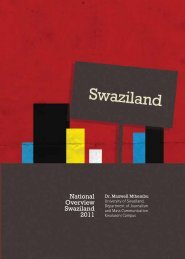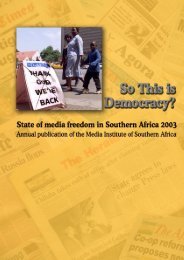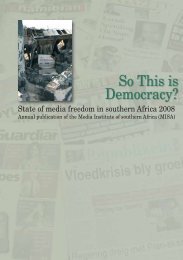Twenty years after the Windhoek Declaration on press freedom
Twenty years after the Windhoek Declaration on press freedom
Twenty years after the Windhoek Declaration on press freedom
You also want an ePaper? Increase the reach of your titles
YUMPU automatically turns print PDFs into web optimized ePapers that Google loves.
How digital TV could drive<br />
informati<strong>on</strong> access<br />
By Guy Berger<br />
Guy Berger is Director-designate for<br />
Freedom of Ex<strong>press</strong>i<strong>on</strong> and Media<br />
Development (FEM) at UNESCO.<br />
He served as head of <str<strong>on</strong>g>the</str<strong>on</strong>g> School of<br />
Journalism and Media Studies at<br />
Rhodes University from 1994 -2010.<br />
He is co-editor with Elizabeth Barratt<br />
of “50 <str<strong>on</strong>g>years</str<strong>on</strong>g> of African Journalism”<br />
which is available at www.<br />
highwayafrica.com. His research is<br />
<strong>on</strong>line at http://guyberger.ru.ac.za<br />
Africa is famous for <str<strong>on</strong>g>the</str<strong>on</strong>g> migrati<strong>on</strong>s<br />
of wildlife across <str<strong>on</strong>g>the</str<strong>on</strong>g> Serengeti; now<br />
<str<strong>on</strong>g>the</str<strong>on</strong>g> c<strong>on</strong>tinent faces a migrati<strong>on</strong> off<br />
<str<strong>on</strong>g>the</str<strong>on</strong>g> ground.<br />
In <str<strong>on</strong>g>the</str<strong>on</strong>g> next five <str<strong>on</strong>g>years</str<strong>on</strong>g>, African TV<br />
broadcasting will have to leave<br />
analogue signals behind in favour<br />
of digital distributi<strong>on</strong>, and in so<br />
doing also shift from <strong>on</strong>e part of <str<strong>on</strong>g>the</str<strong>on</strong>g><br />
airwaves to ano<str<strong>on</strong>g>the</str<strong>on</strong>g>r.<br />
This “digital migrati<strong>on</strong>” trajectory<br />
is not to be c<strong>on</strong>fused with satellite<br />
TV, which already comes down from<br />
<str<strong>on</strong>g>the</str<strong>on</strong>g> skies in largely digital form. It<br />
is about land-based signals, and is<br />
known as “Digital Terrestrial TV”<br />
(DTT). Radio will remain analogue<br />
FM and MW for a l<strong>on</strong>g time yet.<br />
Here’s what <str<strong>on</strong>g>the</str<strong>on</strong>g> migrati<strong>on</strong> to DTT is<br />
not:<br />
• It is not an automatic change<br />
to High Definiti<strong>on</strong> televisi<strong>on</strong>.<br />
Over <str<strong>on</strong>g>the</str<strong>on</strong>g> medium-term, digital<br />
transmissi<strong>on</strong> of signals will still<br />
mainly be in Standard Definiti<strong>on</strong><br />
in most African countries<br />
• Even High Definiti<strong>on</strong> transmissi<strong>on</strong>s<br />
will not necessarily<br />
show <strong>on</strong> your TV set. The point<br />
is that even if c<strong>on</strong>tent is filmed<br />
Secti<strong>on</strong> 4: Access to Informati<strong>on</strong><br />
in HD, and transmitted in HD, it<br />
is <strong>on</strong>ly HD-enabled TV screens<br />
that can display this quality of<br />
video. Most African TV viewers<br />
are still many <str<strong>on</strong>g>years</str<strong>on</strong>g> away from<br />
getting such costly new TV sets.<br />
• Despite much government<br />
rhetoric, DTT is not a magic<br />
method to overcome <str<strong>on</strong>g>the</str<strong>on</strong>g> digital<br />
divide and provide internet<br />
services, around this. Digital<br />
broadcasting could play a part<br />
in regard to a promised land of<br />
broadband for all, but in most<br />
cases it probably w<strong>on</strong>’t. More<br />
<strong>on</strong> this below.<br />
So here’s what <str<strong>on</strong>g>the</str<strong>on</strong>g> transiti<strong>on</strong><br />
actually is:<br />
• It’s a more efficient way to<br />
transmit broadcast signals.<br />
C<strong>on</strong>sider that a single radiospectrum<br />
frequency used to<br />
be taken up completely by a<br />
sole analogue TV service. One<br />
signal, <strong>on</strong>e channel. But digital,<br />
especially with DVB-T2 data<br />
com<strong>press</strong>i<strong>on</strong>, will be able carry<br />
up to 24 video channels (in<br />
Standard Definiti<strong>on</strong>) <strong>on</strong> just <strong>on</strong>e<br />
“multiplexed” signal.<br />
• The full migrati<strong>on</strong> is very expensive<br />
because it requires<br />
digitisati<strong>on</strong> all al<strong>on</strong>g <str<strong>on</strong>g>the</str<strong>on</strong>g> valuechain:<br />
at <str<strong>on</strong>g>the</str<strong>on</strong>g> point of broadcast<br />
producti<strong>on</strong> (filming, editing,<br />
archives); <str<strong>on</strong>g>the</str<strong>on</strong>g> point of distributi<strong>on</strong><br />
(signal towers); and at <str<strong>on</strong>g>the</str<strong>on</strong>g><br />
point of c<strong>on</strong>sumpti<strong>on</strong> (viewers<br />
will need to buy a “set top box”<br />
to c<strong>on</strong>vert <str<strong>on</strong>g>the</str<strong>on</strong>g> digital signal to<br />
show <strong>on</strong> <str<strong>on</strong>g>the</str<strong>on</strong>g>ir existing analogue<br />
TV sets).<br />
• The spread of <str<strong>on</strong>g>the</str<strong>on</strong>g> process will<br />
take <str<strong>on</strong>g>years</str<strong>on</strong>g> to reach <str<strong>on</strong>g>the</str<strong>on</strong>g> point<br />
where analogue TV signals<br />
can be switched off <strong>on</strong> <str<strong>on</strong>g>the</str<strong>on</strong>g><br />
Media in Africa - 2011 | 169












